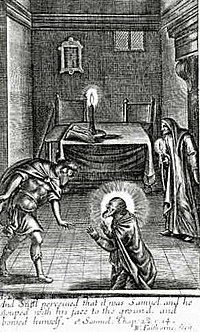Witch of Endor

The Witch of Endor, sometimes called the Medium of Endor, was a woman who called up the ghost of the recently deceased prophet Samuel, at the demand of King Saul of the Kingdom of Israel in the First Book of Samuel, chapter 28:3–25. The same event is mentioned in the Book of Sirach 46:19-20, although the witch is not specifically mentioned.
Story
After Samuel's death and burial with due mourning ceremonies in Ramah, Saul had driven all necromancers and magicians from Israel. Then, in a bitter irony, Saul sought out the witch, anonymously and in disguise, only after he received no answer from God from dreams, prophets, or the Urim and Thummim as to his best course of action against the assembled forces of the Philistines. Following the orders of the king, the woman summons the ghost of Samuel from the abode of the dead, to give him advice.[1] This, however, is not given. After complaining of being awakened from his long sleep, the prophet's ghost berates him for disobeying God, and predicts Saul's downfall, with his whole army, in battle the next day, and adds that Saul and his sons will join him, then, in the abode of the dead. Saul is shocked and afraid, and the next day the army is defeated and Saul commits suicide after being wounded.
Interpretations

In Judaism, some rabbis taught that the spirits of the dead hovered around the body for a year after a person died; this made the spirit of the dead person amenable to being truly summoned during this time, and indicated that the spirit so summoned truly was Samuel, and that Samuel was indeed supernaturally summoned by the witch.
The Church Fathers and some modern Christian writers have debated the theological issues raised by this text, however. If one interprets the Bible literally, it would appear to affirm that it is or was possible for humans to summon the spirits of the blessed dead by magic. Medieval glosses to the Bible naturally suggested that what the witch actually summoned was not the ghost of Samuel, but a demon taking his shape. The modern Christian author Hank Hanegraaff argues that although it is impossible for humans to summon the dead, Samuel did appear before Saul and the witch by a sovereign act of God. Hanegraaff interprets the passage to mean that the witch was surprised by these events.
Regardless of the reality of the witch's power, the story can be seen as a satire on Saul. Once Saul was the righteous king who upheld God's law by his sword; having fallen from God's favour, he is reduced to participating in forbidden rituals. He is given no counsel from the ghost of Samuel, who instead appears to confirm his doom.
In Popular Culture
Rudyard Kipling wrote a poem called En-Dor, about communicating with the dead. It concludes,
Oh the road to En-dor is the oldest road
And the craziest road of all!
Straight it runs to the Witch’s abode,
As it did in the days of Saul,
And nothing has changed of the sorrow in store
For such as go down on the road to En-dor!
The Witch of Endor is featured as a prominent character in Book One of Michael Scott's "The Secrets of the Immortal Nicholas Flamel" as an Elder who has mastered the magic of the Element of Air.
A British frigate with the name The Witch of Endor is mentioned in passing as a part of the English fleet in a later Horatio Hornblower novel set in the Napoleonic Wars.
In Thomas Hardy's Tess of the d'Urbervilles, Alec cries out, "You temptress, Tess, you dear damned witch of Babylon!" The phrase "Witch of Babylon" was, at the time, another way of saying "Witch of Endor".
References
- ^ Geza Vermes (2008) The Resurrection. London, Penguin: 25-6
External links
- Medium of Endor: From the Jewish Encyclopedia
- Visiting the Medium of Endor — Revisiting Adventist Thnetopsychism: A reflection of the Catholic perspective that Samuel actually appeared to Saul
